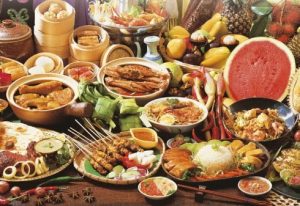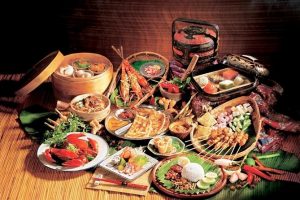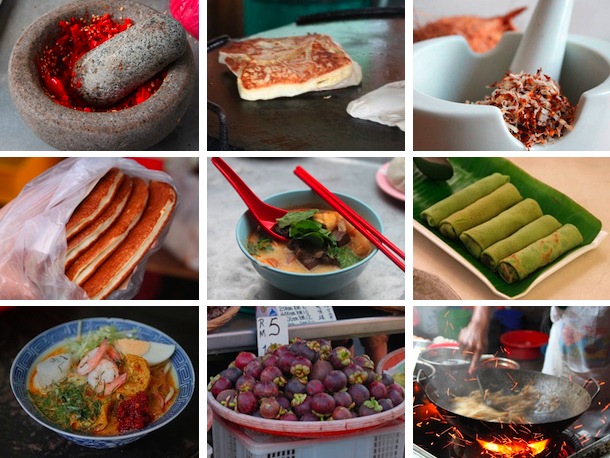In reference to the first part of the Malaysian cuisine post, here is the second part which will focus more the carbs of the Malaysian cuisine and the fruits that this amazing culinary culture has.
In reference to the first part of the Malaysian cuisine post, here is the second part which will focus more the carbs of the Malaysian cuisine and the fruits that this amazing culinary culture has.
Growing up in a multi-cultural society, it is expected that you have defined palate that will be able to distinguish the good from the bad. With a flux of migrants arriving from different cultures, Malaysia happens to be a country where different cultures is brought closer through foods. With an array of herbs and spices derived from Chinese, Indian and Malay cuisine, Malaysian cuisine is nothing more than a reflection of a happy and prosperous culture. As easy-going, relaxed, and warm people, the Malay people have different qualities instilled in them. Often eaten with hands, Malay food is warm and homelike, even when you are eating at a restaurant.
Regardless of what you think, Malaysian cuisine has a trunk full of beauties stored to make anyone crave for foods that they have not tasted yet. As mentioned earlier, I’ll talk about the carbs that the cuisine holds dear.

I’ll start with the base of most Asian dishes and that’s the rice. Rice is the most important staple food in Malaysian cuisine and all Asian cuisine. Malaysia produces about 70% of the amount of rice it needs to feed itself and the rest is imported. Rice is served in different forms – steamed white rice, fried, crushed and other ways. The plain white steamed rice is served with side dishes of meat or vegetables. Compressed rice also called nasi himpit is a method of preparing rice in leaves and compressed into the form of a cylinder, which is later cooked by boiling. The compressed rice is often eaten with some sort of gravy. Another significant way to cook rice is by precooking the rice with coconut milk and wrap it in banana leaves and left to steam until fully cooked. There are different types of locally grown and imported rice available in the market and each has a specific cooking method that brings our the best results.
Glutinous rice is one example as its low amylose and high amylopectin content result in a sticky texture after it is cooked. Glutinous rice is often prepared with different measurements and techniques and is not a good substitute for normal rice or vice versa. This rice is normally used to make snacks or desserts.
Another popular rice dish is nasi lemak, which is rice steamed with coconut milk and pandan leaves to gain a rich fragrance. Of pure Malay origin, nasi lemak is frequently referred to as the national dish. When visiting Malaysia, it is normal that you are served this dish with ikan bilis or fried anchovies, peanuts, sliced cucumber, hard boiled eggs and sambal. Often considered as the breakfast food, nasi lemak is served because of its versatility to be served in different ways. This is a dish that you can eat anytime of the day.
Congee is another type of rice porridge or gruel that is quite popular among Malaysia’s ethnic communities and it is primarily eaten as a breakfast food or late supper as it is easily digestible. Congee is served with plain or with ingredients like fish slices, seafood, chicken, beef, pork, vegetables and even spices. Congee is so prominent in the Malaysian diet that it is even featured on the menu of the Malaysian MC Donald.

Noodles is another staple that is particularly found in the Malaysian Chinese cuisine, there are different types of noodles and all provide an alternative to rice. Stir fry noodles dishes (mee goreng) are seen everywhere throughout the cities, towns and villages and prepared in different ways by various ethnic communities according to their culinary traditions and preferences.
Did you know that Malaysia does not produce wheat and all the supplies are imported from wheat-producing countries? Well, the fact is the fact, but that does not mean there is not wheat to make bread that is another staple. The Western style white breads and Indian breads are quite common in the modern Malaysian diet. The typical way to serve white bread is by having it toasted and spread with kaya, a sweet spread that is made from the base of coconut milk, eggs, and sugar. Traditional wheat-based pleated steamed bao or pao are made. These can be found in restaurants while having a dim sum brunch. It can have sweet filling like tausa, lotus seed paste, pandan, or ground peanuts. The Malay versions maybe found in night markets and they are always halal. There are also specialist bakers who specialize in different types of bread.
2nd part ends with this and look out for the 3rd part!

